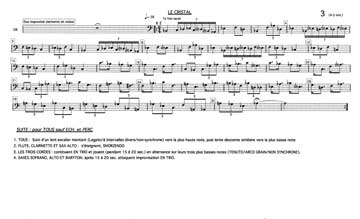
Danielle Palardy Roger
Le Caillou, le cristal et le camion
Listen to Le caillou, le cristal et le camion. Written by Danielle Palardy Roger. SuperMusique ENSEMBLE. Recorded at Théâtre La Chapelle by Radio-Canada on April 26, 1998. Performed by Pierre Cartier (bass), Jean Derome (flute and alto saxophone), Joane Hétu (vocals and alto saxophone), Jean-Denis Levasseur (clarinets), Diane Labrosse (piano and synthesizer), Kristin Molnar (violin), Jean René (alto), Pierre Tanguay (drums).













Danielle Palardy Roger is interested in graphic notation, its integration into standard notation, as well as the differences between the two, and also the contrast between the different performative effects each type of notation brings about. Le caillou, le cristal et le camion (1998) is a series of musical tableaux featuring sections of either purely graphic or standard notation, or juxtapositions of both. It is timed at 17-22 minutes in total and is scored for flute, clarinet, saxophones (soprano, alto, and baritone), voice, piano/electronic sampler, percussion, and strings (violin, viola, and contrabass).
The First Tableau
The first tableau “Le caillou sur le chemin” (3-7 minutes) features a series of episodes that juxtapose an active freely-improvised musical element with either a sustained element indicated as high and discrete, or silence. The instrumentation is constantly varied throughout the tableau. Each successive episode is increasingly longer in duration resulting in a structural decelerando. This is combined with a gradual crescendo from mezzo-forte to fortissimo. Together, these shape the tableau, creating a continuity through the episodic nature of the surface musical activity. Here, Roger combines standard and proportional notation with non-standard graphic notation. The players are challenged to perform the tableau once through as written, and then to repeat the tableau exactly as it was first performed.
The Second Tableau
In the second tableau “Un caillou pas comme les ôtres” (3-4 minutes) Roger continues the episodic nature of the previous tableau. An overall gesture shapes the tableau whereby the musical activity becomes increasingly less structured and increasingly more complex. The tableau begins with relatively regular rhythmic pulsations heard mainly in the percussion in section “A,” and ends with freely-improvised music by the entire ensemble in section “C.” This gesture is notated in terms of a gradual shift from mostly standard and proportional notation in “A,” to mostly graphic notation in “C.”
The Third Tableau
The third tableau “Le cristal” (4-5 minutes) features a main section written in standard notation that is framed by a freely-improvised introduction and “suite” (“continuation”). Transitioning from the final improvised section of the previous tableau, the introduction is indicated only as a duet for clarinet and violin for an indeterminate amount of time. The main section consists of a single melodic line that develops continuously from beginning to end. The melodic line and its transposition by a major second are performed in parallel, adding a certain degree of dissonance to the resultant homophonic texture. It is played twice through, first by a small ensemble and then repeated tutti. The “suite” (“continuation”) following the main section is notated with a set of written instructions calling for contrasts of registral extremes and of timbral groups between the ensemble and the string and saxophone sections.
The Fourth Tableau
The fourth tableau “Le caillou et le cristal” (4-5 minutes) combines the episodic nature of the first tableau with the juxtaposed unison and freely-improvised materials of the third tableau. It features three main sections “A,” “B,” and “C,” where “A” begins with the saxophones continuing their improvised trio from the previous tableau, and ends in “C” with the introduction of machine-inspired samples and rhythmic ideas which transition into the fifth and final tableau.
The Fifth Tableau
In the fifth tableau “Et le camion” (3-4 minutes) Roger gradually layers 3 main contrapuntal lines of varying lengths and number of repetitions. Each line of counterpoint is characterised by a repetitive machine-like rhythmic motif. The contrapuntal texture is juxtaposed with the voice and saxophone parts that gradually transition from mostly vocalised and guttural sounds to screams and embouchure harmonics, respectively, as well as the electronic sampler part that gradually amplifies machine-inspired samples over the course of the entire tableau. The result is a slow increase in musical tension in terms of the density and complexity of the overall texture. The piece ends abruptly at a point of extreme musical tension, with the exhaustion of the contrapuntal materials, and with the voice, saxophones and sampler parts overtaking the ensemble in terms of their levels of volume and dissonance.
Artistic Intentions
One of Roger’s artistic intentions is to create a means for music-making based on a single idea. This basic premise is contained in the first tableau, namely that each freely-improvised section combines different instruments in the given ensemble and is successively longer and louder than the last, forming an overall matrix. The challenge is to repeat the piece exactly as it was just performed after proceeding once through the matrix.
 English |
English |